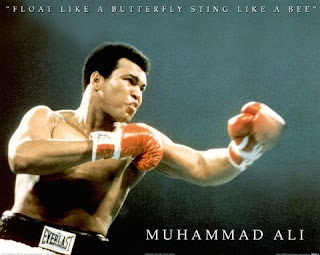The JAB
Boxing coaches will often overemphasize the importance of the jab to their fighters.
“You cannot fight if you can’t throw the jab right.”
Old school trainers live by that code.
The Jab is the fastest offensive tool. It travels a short distance and it is highly intuitive; therefore, very effective if used correctly.
In boxing, successful fighters respect and know the value of the jab. They utilize it in ways that will add to their advantage. Most of the time, the effectiveness of the jab is the deciding factor of the match; the difference between winning and losing. Sometimes, jabs do not need to be powerful, do not even have to land…. But it all depends on its purpose.
Purposes of the Jab
To stun – a well timed and placed jab will stun a rushing opponent; can even KO if enough force is given
To cut and injure - since jabs are frequently thrown and landed more than any other punches, it will most likely, damage the face due to constant beating
To measure – the jab is a good tool to measure your effective range
To keep opponents at bay – if you’re tall and long, you can keep opponents away from their punching range with your long jab
As a set up – a jab will create openings for your power punches to exploit. These set-up jabs do not even have to hit; may be used as a feint just to entice a reaction.
As a defense/counter - rushing opponents will be stopped by a simple jab (stop-hit)
As an entry to shorten the distance – sluggers/in-fighters jab first before going inside; it will create a diversion so a fighter can shorten the distance safely
Types of Jab
There is no absolute way to execute a jab. As long as it serves your purpose, it is considered the right way.
Flicker Jab – a fairly weak jab executed mostly by the arm; does not really hurt but bothers and stings; it commonly serves as to keep the opponent busy as you set-up your power punch; Ali and Hearns used this style.
Double Jab – a jab that is followed by a stronger jab; it is for opponents that try to counter off your first jab. They will get hit by the quick follow-up jab because they think that the first jab will not be followed up or will be followed up by a punch from the other hand.
Double Jab (set-up) – doubling up the jab to set-up a right power punch
Power Jab – generated with most force without telegraphing; the intention is to hurt and stun; a Knockout is also probable
Stiff Jab – quite similar to the power jab but with an added push at the end of the punch by stiffening the arm
Counter Jab – a jab used after parrying or slipping an opponent’s punch
Different opponents pose different problems. So, in effect, there will be a corresponding type of jab suited for a certain fight. A fighter will face different challenges and variety of styles. Sometimes, a boxer will have to fight someone taller, shorter, longer, quicker, tougher, etc… A smart fighter will always adapt to different variables and his jab will also be subject to vary.





To block the opponent from being able to see what you've got coming next? You're putting your glove in his line of sight and so it hides your next shot.
ReplyDelete